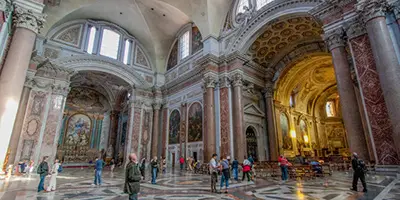In 1541, a Sicilian by the name of Fr. Antonio Lo Duca who was a priest at Santa Maria di Loreto experienced a vision in which the ruins of the Baths of Diocletian were occupied by the angels of the seven martyrs.
This vision convinced the priest that a church should be constructed on the ruins of the baths and he immediately went to the baths to paint the names of the seven archangels upon seven of the ancient bath's eight granite columns, then began his campaign for the construction of the church.
Unfortunately, Pope Paul III, did not agree and construction did not begin until his successor, Pope Julius III consented to allow the church to be built.
It was in 1561 that Pope Pius IV officially inaugurated the commencement of the project. In July of that year, he issued a written statement that decreed the church the be constructed in honour of the Beatissimae Virgini et omnium Angelorum et Martyrum, or the Most Blessed Virgin and all the Angels and Martyrs.
According to the legends, these seven martyrs, Largus, Smaragdus, Cyriac, Sisinnius, Trasonius, Marcellinus, and Saturninus, were slaves who had died during the construction of the ancient Roman baths.
Despite various setbacks that delayed the construction of the basilica, Michelangelo created architectural designs for the church and began work on Santa Maria degli Angeli e dei Martiri in 1563.
Michelangelo designed this Renaissance church so that it would sit inside the frigidarium (a large, cold pool used to tighten the pores after being submerged in the hot bathing pools) of the Baths of Diocletian in the Piazza della Repubblica.
Unfortunately, the basilica was to be the final great work of the famed artist Michelangelo. The year after he began work on Santa Maria degli Angeli e dei Martiri, Michelangelo passed away. He died in 1564, just three weeks before what would have been his 89th birthday. His designs were then completed by his student, Jacopo Lo Duca, who also happened to be the nephew of Fr. Antonio Lo Duca.
Upon completion of the structure, the church was granted to the Carthusians, a Catholic religious order of enclosed monastics founded by Saint Bruno of Cologne in 1084. The order included both monks and nuns who had relocated from their former monastery at Santa Croce in Gerusalemme.
Shortly after their arrival at Santa Maria degli Angeli e dei Martiri, the Carthusians built a monastery next door to it, which may or may not have also been designed by Michelangelo.
Some time later, in the year 1702, Pope Clement XI commissioned Francesco Bianchini, a mathematician, archaeologist, historian, philosopher, and astronomer to design a sundial to be installed on the floor of the church.
This sundial, or meridian line, served multiple functions. Perhaps the most important of these at the time was to validate the accuracy of the new Gregorian calendar. This tool was extremely important to the church, as it gave the pope the means to be able to make an exact prediction of the date of Easter.
This meridian line is set into the floor, running along one side of the basilica. To this day, one can visit Santa Maria degli Angeli e dei Martiri and see this remarkable sundial functioning just as it did during the time of Pope Clement XI.
Through a very small in hole in the wall at the south side of the church, a beam of sunlight breaks though and casts a beam of light directly onto the meridian line in the floor. Each day, at midday, this beam of sunlight travels along the line.
The longer the line, the more precisely one can calculate the length of the year. Bianchini also added some strategically placed holes in the ceiling, which made it possible to then observe the passage of the stars. The meridian sundial was used to set the clocks in Rome for nearly 150 years.
While the Santa Maria degli Angeli e dei Martiri is the final architectural project to come from the creative genius of Michelangelo, it may also quite possibly be one of his finest. Not only is the basilica a remarkable monument to Michelangelo, but it is also a timeless monument to faith, art, science, and Roman history.


